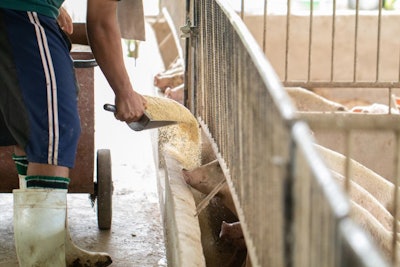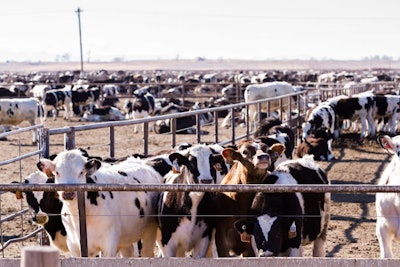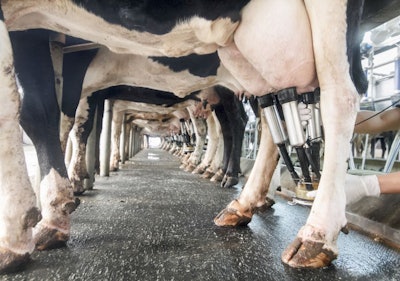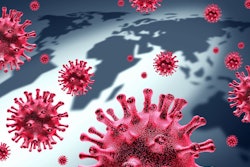
Pig, cattle producers look for ways to buy time as animals back up on-farm during COVID-19-related processing and packing plant interruptions
Meat processing and packing plants have temporarily closed or slowed line speeds as a result of the novel coronavirus (COVID-19) pandemic, causing backups on farms as many producers are unable to bring their animals to market on time.
When a highly efficient system like agricultural production is disrupted, it is felt all the way down the supply chain. Processing and logistical delays caused by the pandemic have led meat producers to seek feeding strategies to slow animal growth and extend the amount of time before they are ready for market. Dairy and egg producers have also been affected as demand has shifted away from foodservice to retail.
“Everything is lined up so nicely because we usually work in such an efficient manner that, when one part of the chain slows or has to shut because they have to do a proper cleanout, then it really impacts many other pieces of the chain,” said Kayla Price, poultry specialist and technical manager at Alltech Canada. “Not just on the farmer/producer side … but different questions like, ‘How do we slow these pigs or maintain this weight?’ as well as, ‘What can we do on the young animal side?’”
Pork production has been hit particularly hard by plant closures. According to an April 30 report, nearly 40% of pork processing capability in the U.S. is offline on any given day.
Chris Hostetler, director of animal science for the National Pork Board, said U.S. pork producers could foresee the slowdown in slaughter capacity in early April and began to strategize how they could hold their animals until they could be scheduled for processing.
But, he said, “this is really a foreign concept to pork producers. As long as we can remember, we’ve always tried to get the pigs to grow to market as quickly and as efficiently as possible. … So, from a business model standpoint, this is new ground.”
Animal nutrition experts recommend strategies for slowing animal growth or production, but they remind producers that any diet changes must be made in cooperation with a nutritionist, nutrition consultant or veterinarian and that animals must be monitored closely.
Strategies to slow pig growth
Low energy, high fiber
To slow pigs’ growth, Hostetler recommends feeding a low-energy, high-fiber diet. John Patience, professor of applied swine nutrition at Iowa State University, said this strategy is the easiest to implement.
“The pigs are still able to eat as much feed as they want, but there’s not as much energy there, so they don’t grow as quickly,” Hostetler said.
Patience said fiber should be increased by 15% to 25% to see a difference.
“If we are really serious about reducing growth rate in these pigs, we have to really elevate the fiber substantially,” he said.
But, Patience noted, fiber can be expensive, and some sources are in short supply during the pandemic, such as dried distillers grains with solubles (DDGS). There is also a higher mycotoxin risk with many high-fiber ingredients because they are made from the outside of the seed, which has a greater exposure.
Limit feeding
Limit feeding is another strategy to reduce the amount of energy in the diet, but Hostetler said this has challenges.
“We’re really not set up as an industry in the U.S. to limit feed pigs because, in order to successfully limit feed pigs … all pigs within the pen need to be able to eat at the very same time,” he said. “We’re just not set up for that in terms of feeder space and feed delivery systems.”
Low protein, low amino acid
Laura Greiner, assistant professor in Iowa State University’s animal science department, suggests feeding pigs a low-protein, low-amino acid diet. She said including lysine at less than 85% of the animal’s requirement is needed to see significant reductions in growth.
“If feed intake is potentially the approach you may want to take, you can look at reducing the tryptophan-to-lysine ratio to 15% or slightly less than that to reduce the feed intake substantially,” she said. “Or, if you have access to red blood cells and it meets biosecurity requirements, some people could consider altering the branched-chain amino acid ratio and that can certainly impact feed intake as well.”
Calcium chloride
Patience said use of calcium chloride in pig diets, while it hasn’t been applied much, increases acid load on pigs, reducing feed intake. This method is only recommended for use for three to four weeks, and not for early in the growth phase. He said this method will cause feed intake to drop substantially in the first week, but the pigs will compensate “a little” after that.
“It’s a fairly technical subject, and when you’re formulating diets with calcium chloride, you add calcium chloride in 3% to 4% of the diet. This is not an inexpensive approach to take because calcium chloride is somewhere around 21 cents a pound,” he said.
Adding to that cost is the need to maintain the calcium-to-phosphorus ratio by adding a source of phosphorus, such as monosodium phosphate, which Patience said is approximately 80 cents per pound.
Patience and Greiner stressed that this strategy requires the pigs to have access to quality drinking water at all times.
Elevated temperatures
Patience said that an elevated temperature in the barn will reduce feed intake, but pig welfare can become an issue.
“For every 2 degrees Fahrenheit above that pig’s comfort zone, we’re going to reduce feed intake on average … by about .1 pound per day, and that’s assuming a comfortable humidity level,” he said. “Humidity by itself will decrease feed intake and if elevated temperature is on top of that, then that’s going to make the reduced feed intake even more.”
However, increased temperature and humidity can stress the pigs.
“Elevating the temperature is one where we want to be very careful about the welfare of the pigs,” he said. “We don’t want to elevate the temperature in the barn excessively and create too much stress on our animals.”
For any of these strategies, Hostetler said, starting earlier will buy producers more time.
“The earlier you do any of this stuff, the more time you can buy,” he said. “In a pig, at best you’re going to buy two weeks of time … more practically, you’d probably slow them down by five or six days.”

Adding roughage to beef cattle diets is key to limiting their weight gain. (urbanlight | Bigstock.com)
Using roughage to maintain cattle weight
Beef producers are facing similar challenges as pork producers, as they are also coping with processing and packing plant shutdowns.
Josh McCann, University of Illinois assistant professor in the department of animal sciences, said this is not likely to be a short-term problem, so beef cattle producers should make feeding adjustments now.
“May and June are our heaviest kill months of the entire year, and so with the reduced capacity at our packing facilities, we certainly believe that these delays of marketing cattle are going to continue on into the summer,” he said, adding that producers should expect slaughtering delays of two to six weeks past the animals’ ideal slaughter date. “We need to recalibrate our target of when we need to market our cattle.”
McCann’s strategy to combat this is to identify and sort cattle by weight. If there are animals that need their weight gain limited, adding roughage to the diet is key and, for cattle more than 1,600 pounds but unable to go to market, limit feeding should be considered.
“This is pretty much the opposite of anything that we ever try to do as a feedlot nutritionist. We’re always trying to maximize gain, and that’s one of the reasons why beef is affordable, and our system is really efficient,” he said. “But in these situations, we’ve kind of flipped the script and it’s the opposite scenario.”
The ideal roughage source for this strategy is silage because it is cost effective, McCann said. Silage inclusion should be increased to 50% or more of the diet. If extra silage is not available, use the lowest-cost and lowest-protein roughage available, at 20-25% of the diet.
“Many cattle feeders probably have some type of forage on farm, whether it be corn silage, hay silage, hay or even corn stover or corn stalks,” said Travis Meteer, University of Illinois beef extension specialist. “These poor-quality forages could be ground and included into a finishing ration to slow them down. If cattle feeders do not have some of those feedstuffs available or their budget doesn’t suit this extended feeding period, they may need to identify some available off-farm feedstuffs.”
He added that last year’s poor-quality hay can be ground to create a roughage source.
If roughage is not an option or producers want to further reduce feed cost, they can remove all of the expensive additives except for ionophores and reduce protein, as well as use cheaper minerals. If even further cost savings are sought, consider limit feeding or utilizing available pasture, McCann said.

If increasing on-farm forage inclusion is not an option, producers should determine which available protein sources can deliver the most protein at the lowest cost. (AT Studio | Bigstock.com)
Cost savings in dairy production
In the dairy sector, the challenge for producers is having too much milk and nowhere to send it, as schools and restaurants buy the most dairy products. But there are ways to adjust nutrition to slow milk production, according to Jon Pretz, dairy nutritionist for Hubbard Feeds.
“I would first re-evaluate on-farm forage inventories and make a plan to utilize as much on-farm, home-grown forage and ingredients as you can,” he said. “If inventories allow, this will likely look like increased corn silage inclusion while reducing purchased energy sources such as corn, hominy and fat/sugar and an increase in alfalfa haylage or hay while decreasing purchased protein sources (i.e. soybean meal, distillers, bypass proteins).”
If increasing on-farm forage inclusion is not an option, producers should determine which available protein sources can deliver the most protein at the lowest cost.
“When decreasing the protein content in rations, it is important to keep your dietary energy and protein in ratio to ensure cows do not become overconditioned,” he said.
Changes should be made in “small increments as significant drops in nutrients delivered to cows in early lactation may limit her upward potential later in the lactation, if the producer’s goals change towards making more milk later on,” Pretz said.
Poultry and egg demand shifts
For animals such as poultry, which have been bred to optimize growth and production, Price noted that nutritional adjustments can only make so much difference to counteract an animal’s genetics.
“An animal that has been bred to grow quickly and efficiently will continue to grow quickly and efficiently,” she said. “Changing nutrition can help, but it will not be able to change the bird’s nature. … To dramatically change how the bird grows means changing the genetics and this takes a lot of time and planning.”
She said fiber can be added to a bird’s diet to maintain its weight for a longer period of time.
“The fiber does not encourage growth but allows the animal to feel fuller for a longer period of time,” she said.
Shifting demand away from foodservice to retail means there is more demand for smaller birds in the broiler and turkey market for the grocery stores. Price said larger birds are often used for further processing for institutional dining.
“Buying patterns have shifted from retail to grocery stores and consumers expect and are comfortable cooking what they always have cooked, which are the smaller birds,” she said.
Similarly, in the egg market, different egg sizes are used in different channels.
“The medium-sized eggs and liquid eggs are most often used in retail markets, whereas large eggs are most commonly what consumers buy at the grocery store,” Price said. “Again, due to the emergency measures established during this pandemic, the buying patterns have shifted towards the grocery store and large eggs. These changes have meant that the processor needed to adjust what is being produced and, to some extent during these measures, the consumers needed to adjust to sometimes seeing something different on the grocery shelves.”
View our continuing coverage of the novel coronavirus (COVID-19) pandemic.











